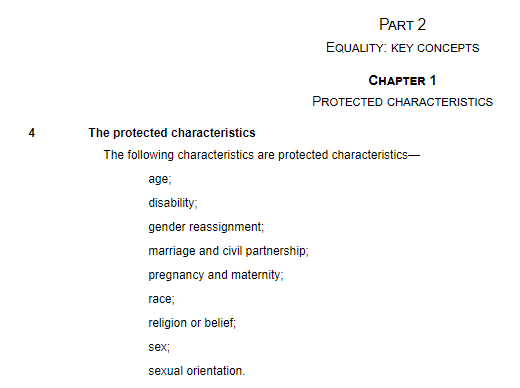
Hi @InclusiveBoards @EHRC @EHRCChair @KishwerFalkner @RJHilsenrath @trussliz @GEOgovuk
The Diversity Monitoring Form in your job application mentions the Equality Act 2010 but asks "What is your gender?" with options:
Man
Woman
Non-binary
Other
1/14
docs.google.com/forms/d/e/1FAI…

The Diversity Monitoring Form in your job application mentions the Equality Act 2010 but asks "What is your gender?" with options:
Man
Woman
Non-binary
Other
1/14
docs.google.com/forms/d/e/1FAI…


'Gender' is not a protected characteristic under the Equality Act 2010 and is not defined in the Act.
legislation.gov.uk/ukpga/2010/15/…
2/14
legislation.gov.uk/ukpga/2010/15/…
2/14

Sex is the protected characteristic and the only two possible options for sex are 'Female' and 'Male' as defined in the Act and consistent with biology - 'non-binary' and 'other' are not valid options.
legislation.gov.uk/ukpga/2010/15/…
'Gender' is not a synonym for sex.
3/14
legislation.gov.uk/ukpga/2010/15/…
'Gender' is not a synonym for sex.
3/14

Man and woman are the terms associated with the protected characteristic of sex in the Act.
You then ask "If you identify as transsexual, transgender (in that you have effected a permanent change of gender identity) or as intersex which group do you identify with?"
4/14
4/14
'Transgender', 'intersex' and 'gender identity' are not protected characteristics under the Equality Act 2010 and are not defined in the Act.
legislation.gov.uk/ukpga/2010/15/…
5/14
legislation.gov.uk/ukpga/2010/15/…
5/14

Intersex is not a 'gender identity' and those with a Difference of Sex Development are still male or female. It is generally considered derogatory to those with DSDs to consider them not to be male or female.
6/14
6/14
You then ask "Is your gender identity the same as the gender you were originally assigned at birth?"
Again, 'gender identity' and 'gender' are not protected characteristics under the Equality Act 2010 and are not defined in the Act.
7/14
Again, 'gender identity' and 'gender' are not protected characteristics under the Equality Act 2010 and are not defined in the Act.
7/14
'Gender' at birth is a meaningless concept and is not 'assigned' ay birth: sex is observed and recorded and is immutable.
'Gender' relies on demeaning, regressive stereotypical notions of societal roles for the two sexes.
8/14
'Gender' relies on demeaning, regressive stereotypical notions of societal roles for the two sexes.
8/14
There is a protected characteristic of 'gender reassignment', but most of the terms you use here are not used or defined in the Act.
legislation.gov.uk/ukpga/2010/15/…
9/14
legislation.gov.uk/ukpga/2010/15/…
9/14
Asking about a personal characteristic such as 'gender' that is not a protected characteristic under the Act, may be in breach of the GDPR by processing personal - and potentially Special Category - data without a lawful basis.
10/14
10/14
If you choose not to gather data on specific protected characteristics (such as sex), you cannot have the information required to ascertain whether or not you could be discriminating on protected characteristics in recruitment. This could be vital in an employment tribunal
11/14
11/14
If you choose to discriminate on characteristics (such as 'gender') that are not protected characteristics under the Act, you may inadvertently indirectly discriminate on protected grounds.
12/14
12/14
Language and meaning of words are important and proper use & understanding of terms is vital so that the public is aware of what rights they have and what your duties are. Any confusion or inconsistency over meaning may prevent people from accessing their rights in law.
13/14
13/14
Will you undertake to correct these errors and to review all your other policies, documents, reports, etc to ensure compliance?
Please respond.
sexnotgender.info/list
14/14
Please respond.
sexnotgender.info/list
14/14
@threadreaderapp unroll
• • •
Missing some Tweet in this thread? You can try to
force a refresh




















